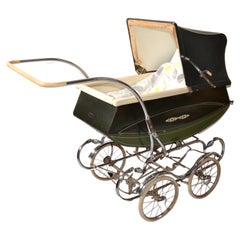English Baby Pram
Vintage 1950s English Mid-Century Modern Children's Furniture
Metal, Chrome
People Also Browsed
21st Century and Contemporary Books
Foil
Antique 19th Century French Napoleon III Stairs
Walnut
Antique 1870s British Victorian Beds and Bed Frames
Brass, Iron
Antique Early 19th Century English Gothic Revival Musical Instruments
Brass
Mid-20th Century Italian Mid-Century Modern Bookcases
Stained Glass, Wood
Antique Early 1900s French Chinoiserie Armchairs
Velvet, Giltwood, Lacquer
Vintage 1970s Italian Hollywood Regency Dry Bars
Brass, Steel, Chrome
Antique 1890s Windows
Glass
Vintage 1970s American Mid-Century Modern Cabinets
Brass
Antique Late 19th Century French Art Nouveau Books
Brass
21st Century and Contemporary Architectural Elements
Ceramic
20th Century American Art Nouveau Glass
Glass
Antique 1890s English Victorian Chairs
Wood
Vintage 1940s Italian Baroque Revival Wall Mirrors
Wood
Antique Mid-19th Century English Louis XIV Centerpieces
Silver
Antique 19th Century French Louis XVI Living Room Sets
Tapestry, Giltwood
Finding the Right Childrens-furniture for You
When you’re shopping for antique, new and vintage children’s furniture, you’ll want your choices to fit nicely within the decor scheme of the rest of your home. But you’ll also want to create an alluring and inspirational space for your children to feel relaxed and encouraged creatively. Indeed, a child’s room can be simultaneously stylish and playful — the ideal environment for children.
Understandably, beds were the first piece of furniture designed for young children. In Ancient Egypt, children’s beds were scaled-down versions of adult beds. They were intended to be a logical size for a child and low enough to the ground so that they could climb in by themselves.
Historians discovered early high chairs in Ancient Greece. In the 6th century B.C., a child’s training potty might have also been used as a high chair, while archaeologists on a dig discovered a terracotta high chair in a marketplace in Athens. By the Renaissance period, children’s bookshelves were popular with upper-class families who had disposable income and the desire to beautify all areas of the home. The original purpose was to organize school books, but shelves eventually became integral to children’s rooms of the era.
In the early 20th century, Italian physician Maria Montessori changed the way designers thought about children’s furniture. She wrote that it was important for children to have a safe environment of their own that they could easily navigate. Montessori believed that children’s furniture should be sized for them but that it should also be made of light, durable materials so that it’s easy for them to carry if needed.
Today’s widely known mid-century modern furniture designers took interest in the idea that young children should have well-crafted furniture of their own. You can find vintage mid-century modern children’s furniture created by the likes of Harry Bertoia, Charles and Ray Eames and Alvar Aalto. Contemporary industrial designer and architect Philippe Starck is also known for having introduced versions of his furniture that were geared toward children, especially his seating and storage solutions.
It’s never too early for good design. Decorating a child’s room offers the opportunity to combine elevated furnishings and a youthful spirit and can result in spaces that are at once elegant and whimsical. On 1stDibs, find design ideas for children’s rooms as well as a variety of new, antique and vintage children’s furniture today.
